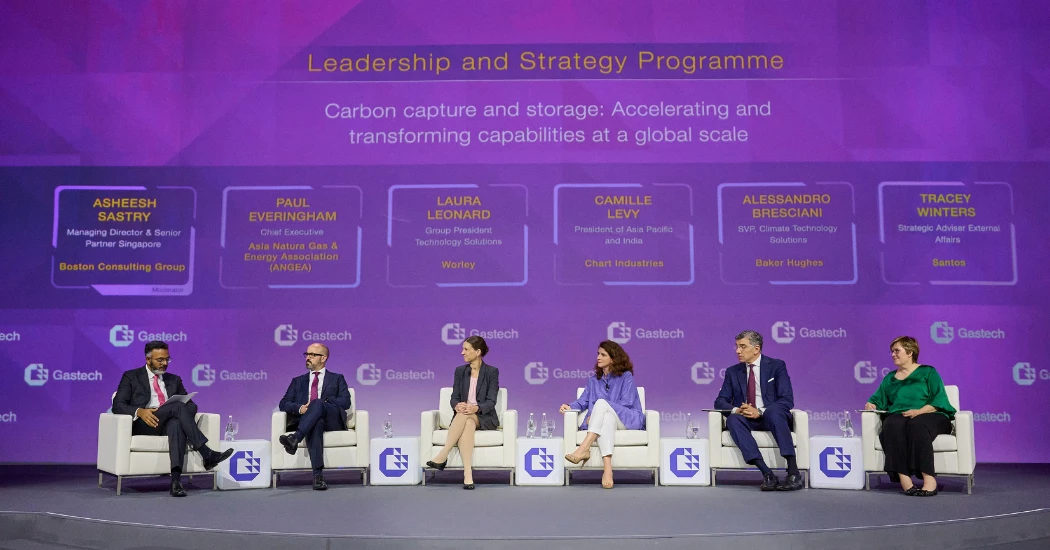Transforming CCS capabilities at a global scale
Carbon capture and storage is a proven and critical player on the pathway to a cleaner world but requires scale for cost effectiveness and robust policies to harness the true benefits. Plenty of optimism accompanied that overall message during yesterday’s Global Business Leadership Panel Carbon capture and storage: Accelerating and transforming capabilities at a global scale.
Laura Leonard, Group President of Technology Solutions, Worley, said: “There’s unlikely to be a path to net zero by 2050 that doesn’t include carbon capture…the good news is the technology is ready now, particularly on the capture side.
“As an engineer, one of the most exciting things is that we have new problems to solve as an industry and we can apply things we already know.” Leonard also called for creating standardised project delivery models to gain efficiencies as well as “unprecedented levels of collaboration across the value chain”. Worley is working on 300-plus projects worldwide, 35 in advanced stages. “We’ve been able to develop global expertise that we’re sharing across the world so we’re driving down the cost of executing those projects while deploying the latest and greatest technology.”
Paul Everingham, Chief Executive of Asia Natural Gas & Energy Association, said CCS was spoken by some people poorly, “but it’s a proven technology done at scale in Australia, the United States and in Europe”.
He cited reducing CCS costs as a challenge so “it is affordable in Asia where energy demand and energy growth is going to take place over the next 40-50 years” as well as storage limitations in North Asian large-emitting countries with CO2 transport not currently permitted under the London Protocol. Everingham said ANGEA was doing a detailed Asia Pacific study that looks at carbon capture, transport, storage, and potentially a carbon price on carbon credit mechanisms “so there would be an entire regulatory framework…looking at the big emitters, their requirements, the potential recipients…hopefully using that in powerful ways…also giving certainty to financiers and engineers”. “Legislative mechanisms don’t exist in a lot of countries - we’re going to be looking at all those hurdles and solutions to remove them.”
Alessandro Bresciani, Baker Hughes’s SVP of Climate Technology Solutions also raised the issue of policy. “You need to have stable regulation - when you plan for 20 years a project, you need certainty, discipline.” Baker Hughes was committed to CCS segment, “active across the board” investing technology and multiple start-ups, he said. “Now is the moment where these good ideas need to become a scalable pilot and then a couple of other steps before you’re going to get this technology deployed in the field.
“It’s going to take some time and a really significant amount of money. Not necessarily you do that by yourself, you do that in partnership, through specific projects with customers. That’s really the way to accelerate the entire process.” Camille Levy, President of Asia Pacific and India, Chart Industries, said her firm had technology solutions well suited to retrofits. “I get excited, because we’re going to be reusing a lot of existing technology - technology is not the issue, the problem we’re facing is how to gain scale. “It’s all about how we lower the cost of abatement, so really bringing efficiency at every single step of the value chain. How you make CO2 removal the most efficient you can. We’re confident…we’ve all done this for years.”
Levy said she believed Asia had very strong potential to be the forefront of CCS - something echoed by Everingham who predicted Asia Pacific could lead the world as its displaced coal usage in many countries. “You see a large part of emerging Asia still industrialising, but also having CCS as a significant industry within their portfolio…that employs a lot of people, that generates income for a lot of emerging countries,” he said. “We won’t be all the way where we need to be within 10 years. But we will be significantly down the path of multiple projects in different geographies across the Asia Pacific, able to capture, transport and store across the Asia Pacific, in a uniform manner with a price on carbon and outperforming our North Atlantic peers.”
Tracey Winters, Strategic Advisor External Affairs, Santos highlighted use of depleted oil and gas reservoirs in her company’s three-hub CCS Australian project. “We know these reservoirs can safely and permanently store carbon dioxide, because they’ve held oil and gas in place for tens of millions of years previously.”






